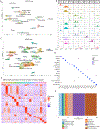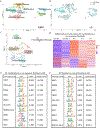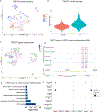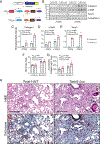Single-nucleus chromatin accessibility identifies a critical role for TWIST1 in idiopathic pulmonary fibrosis myofibroblast activity
- PMID: 37142338
- PMCID: PMC10411550
- DOI: 10.1183/13993003.00474-2022
Single-nucleus chromatin accessibility identifies a critical role for TWIST1 in idiopathic pulmonary fibrosis myofibroblast activity
Abstract
Background: In idiopathic pulmonary fibrosis (IPF), myofibroblasts are key effectors of fibrosis and architectural distortion by excessive deposition of extracellular matrix and their acquired contractile capacity. Single-cell RNA-sequencing (scRNA-seq) has precisely defined the IPF myofibroblast transcriptome, but identifying critical transcription factor activity by this approach is imprecise.
Methods: We performed single-nucleus assay for transposase-accessible chromatin sequencing on explanted lungs from patients with IPF (n=3) and donor controls (n=2) and integrated this with a larger scRNA-seq dataset (10 IPF, eight controls) to identify differentially accessible chromatin regions and enriched transcription factor motifs within lung cell populations. We performed RNA-sequencing on pulmonary fibroblasts of bleomycin-injured Twist1-overexpressing COL1A2 Cre-ER mice to examine alterations in fibrosis-relevant pathways following Twist1 overexpression in collagen-producing cells.
Results: TWIST1, and other E-box transcription factor motifs, were significantly enriched in open chromatin of IPF myofibroblasts compared to both IPF nonmyogenic (log2 fold change (FC) 8.909, adjusted p-value 1.82×10-35) and control fibroblasts (log2FC 8.975, adjusted p-value 3.72×10-28). TWIST1 expression was selectively upregulated in IPF myofibroblasts (log2FC 3.136, adjusted p-value 1.41×10- 24), with two regions of TWIST1 having significantly increased accessibility in IPF myofibroblasts. Overexpression of Twist1 in COL1A2-expressing fibroblasts of bleomycin-injured mice resulted in increased collagen synthesis and upregulation of genes with enriched chromatin accessibility in IPF myofibroblasts.
Conclusions: Our studies utilising human multiomic single-cell analyses combined with in vivo murine disease models confirm a critical regulatory function for TWIST1 in IPF myofibroblast activity in the fibrotic lung. Understanding the global process of opening TWIST1 and other E-box transcription factor motifs that govern myofibroblast differentiation may identify new therapeutic interventions for fibrotic pulmonary diseases.
Copyright ©The authors 2023. For reproduction rights and permissions contact permissions@ersnet.org.
Conflict of interest statement
Conflict of interest: R. Lafyatis reports the following conflicts of interest outside the scope of work of this manuscript: R. Lafyatis has served as a consultant for Pfizer, Bristol Myers Squibb, Boehringer Ingelheim, Formation, Sanofi, Boehringer-Mannheim, Merck and Genentech/Roche, and holds or recently had research grants from Corbus, Formation, Moderna, Regeneron, Pfizer and Kiniksa, and holds equity in Thirona. All other authors report no relevant conflicts of interest.
Figures






Comment in
-
ATAC-ing single nucleus in idiopathic pulmonary fibrosis: TWIST1 strives back for myofibroblasts.Eur Respir J. 2023 Jul 7;62(1):2300881. doi: 10.1183/13993003.00881-2023. Print 2023 Jul. Eur Respir J. 2023. PMID: 37419523 No abstract available.
References
-
- Pardo A, Selman M. The Interplay of the Genetic Architecture, Aging, and Environmental Factors in the Pathogenesis of Idiopathic Pulmonary Fibrosis. Am J Respir Cell Mol Biol 2021: 64(2): 163–172. - PubMed
Publication types
MeSH terms
Substances
Grants and funding
LinkOut - more resources
Full Text Sources
Molecular Biology Databases
Miscellaneous
